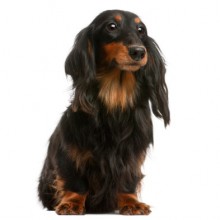Dachshund – Standard (Smooth, Long, Wire-Haired)
Lifestyle Needs
 The Dachshund is a long bodied dog with very short legs, originally to allow the dog to work underground. He is a companion dog who needs to be well trained to suit his independent spirit. Despite the short length of his legs he does need daily exercise of up to an hour. All three coats require regular, at least weekly, grooming. More regular coat care will be needed with the long-haired coat, and the wire-haired coat will typically need to be ‘stripped’ a couple of times a year. Temperaments should be bold and outgoing. Look for moderation in body length and leg height when choosing a puppy.
The Dachshund is a long bodied dog with very short legs, originally to allow the dog to work underground. He is a companion dog who needs to be well trained to suit his independent spirit. Despite the short length of his legs he does need daily exercise of up to an hour. All three coats require regular, at least weekly, grooming. More regular coat care will be needed with the long-haired coat, and the wire-haired coat will typically need to be ‘stripped’ a couple of times a year. Temperaments should be bold and outgoing. Look for moderation in body length and leg height when choosing a puppy.
Genetic Diversity
(Known as Coefficient of Inbreeding: 'COI'. It should be as low as possible.)
The UK Kennel Club breed average COI is 14.6% (long coat), 8.5% (smooth coat), 6.1% (wire coat) - See 'A Beginners Guide to COI'
Gene Pool Size
(Known as Effective Population Size: 'EPS')
39.5 (long coat), 59.1 (smooth coat), 298.2 (wire coat)
EPS is a measure of how many individuals are contributing genetically to a breed population. It is a measure of the size of the gene pool in a breed. Lower than 100 is considered critical by conservationists and below 50 brings a breed close to extinction. For more information see the Kennel Club article.
Health and Welfare Problems due to Conformation
(Body shape and physical characteristics)
- The Dachshund’s long back and Achondroplasia (dwarfism) are associated with Intervertebral disc disease (IVDD). It is reported that between 20-25% of Dachshunds will suffer some degree of back problems during their life. This can range from minor back pain through to severe spinal damage and paralysis.
BVA/KC Health Schemes: www.bva.co.uk/chs
KC/Dachshund Health UK X-ray test for Intervertebral Disc Disease (IVDD) Grades 0-3
www.dachshund-ivdd.uk
BVA/KC Eye Disease Scheme
Estimated Breeding Values (EBVs) : No EBVs are currently available for this breed
www.thekennelclub.org.uk/about-ebvs
DNA Tests Available
DogWellNet and IPFD Harmonisation of Genetic Testing for Dogs (HGTD)
www.dogwellnet.com/breeds
Longhaired
N/A
Smooth
- Progressive Retinal Atrophy crd 4
Wirehaired
- Progressive retinal atrophy (crd 1)
- Progressive retinal atrophy (crd 4)
Availability of a DNA test does not mean that it is always necessary or even desirable for breeders to use this test.
Other Breed-Specific Health Screening Schemes
Dachshund Breed Council’s health website: www.uk-dachshund-health-report.org.uk
Ask the breeder to show you the certificates for the above tests/screening for both parents. If any of the above tests have not been considered necessary by the breeder (and there may be good reasons), ask her to explain why.
Other Diseases Reported
(For which there are currently no genetic or screening tests for sire or dam)
- Skin Allergies
Ask the breeder about the medical history of the parents, grandparents and great grandparents. Consider carefully whether to purchase a puppy if some of these or other diseases are in the family line.
Ask about the breeder’s policy in cases of serious genetic diseases occurring to your puppy in later life. Good breeders will request to be informed of such events in order to improve future breeding decisions.
You are strongly advised to buy from a breeder who uses (or is prepared to use) the AWF Puppy Contract and Puppy Information Pack (PIP): www.puppycontract.org.uk
The breeder should also be familiar with the CFSG/DBRG Code of Practice for Dog Breeding